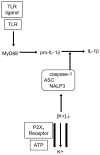Towards an understanding of the adjuvant action of aluminium
- PMID: 19247370
- PMCID: PMC3147301
- DOI: 10.1038/nri2510
Towards an understanding of the adjuvant action of aluminium
Abstract
The efficacy of vaccines depends on the presence of an adjuvant in conjunction with the antigen. Of these adjuvants, the ones that contain aluminium, which were first discovered empirically in 1926, are currently the most widely used. However, a detailed understanding of their mechanism of action has only started to be revealed. In this Timeline article, we briefly describe the initial discovery of aluminium adjuvants and discuss historically important advances. We also summarize recent progress in the field and discuss their implications and the remaining questions on how these adjuvants work.
Figures



References
-
- von Behring E. Ueber ein neues diphtherieschutzmittel. Dtsch Med Wschr. 1913;39:873–876.
-
- Ramon G. Sur le pouvoir floculant et sur les proprietes immunisantes d’une toxine diphtherique rendue anatoxique. CR hebd Seances Acad Sci. 1923;177:1338–1340.
-
- Glenny AT, Pope CG, Waddington H, Wallace U. Immunological Notes: XVII–XXIV. J Pathol Bacteriol. 1926;29:31–40.
-
- Grun JL, Maurer PH. Different T helper cell subsets elicited in mice utilizing two different adjuvant vehicles: the role of endogenous interleukin 1 in proliferative responses. Cell Immunol. 1989;121:134–145. - PubMed
Publication types
MeSH terms
Substances
Grants and funding
LinkOut - more resources
Full Text Sources
Other Literature Sources
Miscellaneous

